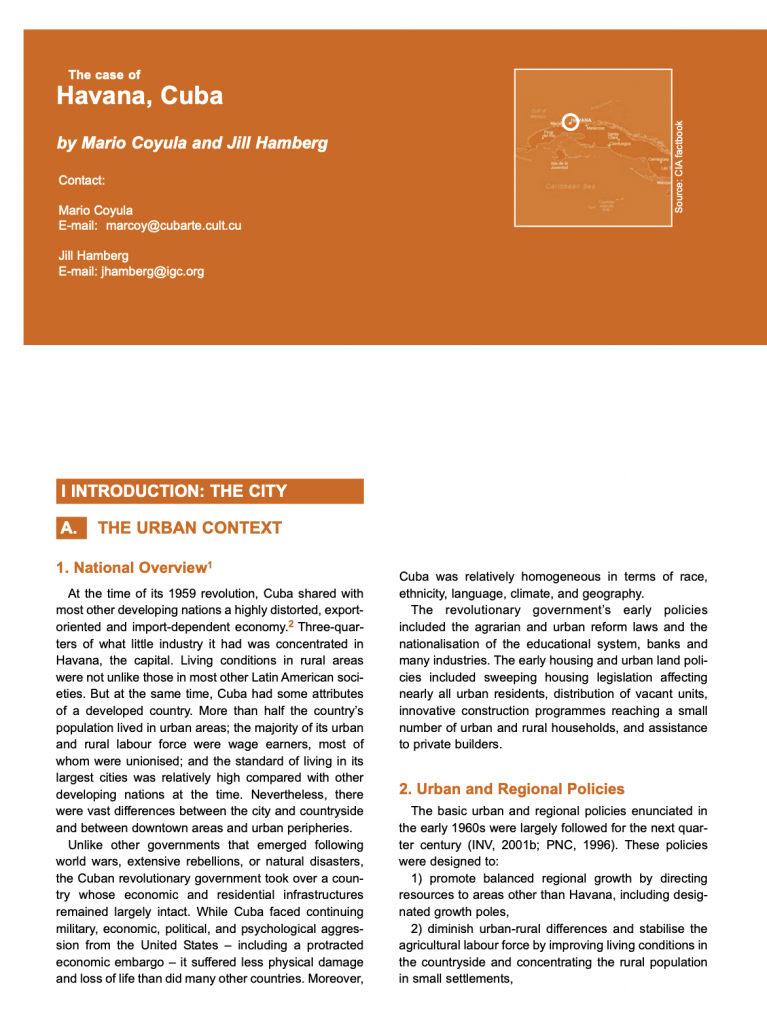This report was prepared by Mario Coyula and Jill Hamburg in 2003 for a project titled: UNDERSTANDING SLUMS: Case Studies for the Global Report on Human Settlements 2003.
It is posted here as an invaluable resource not only for all of its contents, but also a guide to the terminology of urban development in Cuba.
It includes many fully explained terms which often appear in posts on Translating Cuba.
Following is the glossary from the end of the article:
Albergados: Literally “sheltered”. Current or former residents of housing so deteriorated that they registered on special list for replacement housing.
Albergues: Transitional homeless shelters.
Almendrones: Privately owned 1950s American cars that provide group taxi service along fixed routes with a standard fare.
Barbacoa: Makeshift mezzanines or loft-like structures that create an extra floor. [The literal translation is ‘barbecue’.]
Barrio de indigentes: Literally “neighbourhood of indigents”. Term for shantytown before the 1959 revolution.
Barrio insalubre: Literally “unhealthy neighbourhood”. Term for shantytown after the 1959 revolution.
Bicitaxis: Bicycle taxis carrying up to two passengers.
Bohío: Thatched-roof shacks that were once common in rural areas.
Calzadas: Wide streets with tall porticoed pedestrian corridors.
Camellos: “Camel”, double-humped buses composed of a truck cab and chassis and bus bodies carrying up to 220 passengers.
Casas quintas: Detached neo-classical villas.
Casa de vecindad: Type of tenement: Smaller subdivided house, generally with 12 rooms or less.
Casetas en azoteas: Makeshift structures built on top of multifamily buildings.
Ciudadela: Type of tenement: consists of a single or double row of rooms built along a long, narrow courtyard.
Comités de Defensa de la Revolución (CDR): Committees for the Defence of the Revolution.
Comunidad de tránsito: Transitional homeless shelter.
Cocotaxis: A taxi-scooter with a bright yellow round plastic body carrying up to two passengers.
Cuartería: Type of tenement: large mansion or older hotel or boarding house subdivided into rooms.
INV: National Housing Institute (begun in 1985).
Pasaje: Double row of small dwellings (similar to efficiencies) consisting of living-dining, kitchenette, one bedroom, bathroom and a small service courtyard, set along a long, narrow alley usually open to streets at both ends.
Plan con las Masas: Plan with the Masses (1960s maintenance and repair programme) involving residents, with State supplying technical assistance, equipment and low-priced building materials.
Programa de Desarrollo Human Local, PDHL: Local Human Development Programme of UNDP (United National Development Programme).
Poder Popular: People’s Power, name of Cuban government structure.
Solar: Popular term to refer to all forms of buildings subdivided into single-room units, usually with shared services.
Talleres de Transformación Integral del Barrio, TTIB: Neighbourhood Transformation Workshops.
Tugurio: Slum.
Unión de Jóvenes Comunistas, UJC: Union of Young Communists.
Usufructo: Usufruct (long-term leaseholding).
Vivienda adecuada: “Adequate” (standard) housing for change of legal status of tenements or shantytown units.
Vivienda de bajo consumo, vivienda económica: “Low consumption” housing that minimises the use of imported energy-intensive materials

